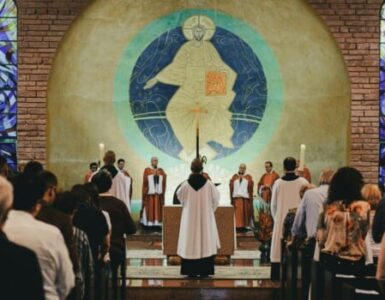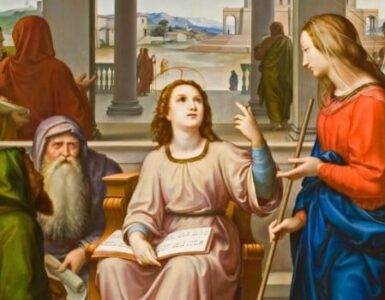
 As we learn each week from the saints, one must wonder, “How did the saints celebrate Christmas?” One of the best examples whose celebration lives on in our own is St. Francis of Assisi (1181-1226). Thomas of Celano, one of the first biographers of St. Francis, wrote, “More than any other feast, he celebrated Christmas with an indescribable joy. He said that this was the feast of feasts, for on this day God became a little child and sucked milk like all human children. Francis embraced with great tenderness and devotion the pictures of the child Jesus and stammered words of tenderness, full of compassion, in the way children do. On his lips, the name of Jesus was sweet as honey.”
As we learn each week from the saints, one must wonder, “How did the saints celebrate Christmas?” One of the best examples whose celebration lives on in our own is St. Francis of Assisi (1181-1226). Thomas of Celano, one of the first biographers of St. Francis, wrote, “More than any other feast, he celebrated Christmas with an indescribable joy. He said that this was the feast of feasts, for on this day God became a little child and sucked milk like all human children. Francis embraced with great tenderness and devotion the pictures of the child Jesus and stammered words of tenderness, full of compassion, in the way children do. On his lips, the name of Jesus was sweet as honey.”
In the year 1223, St. Francis, a deacon, was visiting the town of Greccio to celebrate Christmas. Greccio was a small town built on a mountainside overlooking a beautiful valley. The people had cultivated the fertile area with vineyards. St. Francis loved the quiet and simplicity of the little town; it may well have reminded him of Bethlehem where he had visited.
St. Francis realized that the chapel of the Franciscan hermitage would be too small to hold the congregation for midnight Mass. So he found a niche in the rock near the town square and set up the altar. To make this Christmas celebration even more memorable, St. Francis borrowed an ox and an ass from a farmer and set up a manger; he also placed there the statues of St. Joseph and the Blessed Mother along with a little baby doll to serve as Jesus. However, this midnight Mass would be very special.
St. Bonaventure (d. 1274) in his The Life of St. Francis of Assisi tells the story the best:
It happened in the third year before his death, that in order to excite the inhabitants of Greccio to commemorate the nativity of the Infant Jesus with great devotion, (St. Francis) determined to keep it with all possible solemnity; and lest he should be accused of lightness or novelty, he asked and obtained the permission of the sovereign Pontiff.
Then he prepared a manger, and brought hay, and an ox and an ass to the place appointed. The brethren were summoned, the people ran together, the forest resounded with their voices, and that venerable night was made glorious by many and brilliant lights and sonorous psalms of praise. The man of God (St. Francis) stood before the manger, full of devotion and piety, bathed in tears and radiant with joy; the Holy Gospel was chanted by Francis, the Levite of Christ.
Then he preached to the people around the nativity of the poor King; and being unable to utter His Name for the tenderness of his love, he called Him the Babe of Bethlehem. A certain valiant and veracious soldier, Master John of Greccio, who, for the love of Christ, had left the warfare of this world, and become a dear friend of this holy man, affirmed that he beheld an Infant marvelously beautiful, sleeping in the manger, Whom the blessed Father Francis embraced with both his arms, as if he would awake Him from sleep.
This vision of the devout soldier is credible, not only by reason of the sanctity of him that saw it, but by reason of the miracles, which afterwards confirmed its truth. For the example of Francis, if it be considered by the world, is doubtless sufficient to excite all hearts which are negligent in the faith of Christ; and the hay of that manger, being preserved by the people, miraculously cured all diseases of cattle, and many other pestilences; God thus in all things glorifying His servant, and witnessing to the great efficacy of his holy prayers by manifest prodigies and miracles.
One can only imagine the ineffable joy of holding Baby Jesus, the Incarnate Word. Pope Benedict XVI in his homily at midnight Mass in 2006, preached:
God’s sign is simplicity. God’s sign is the baby. God’s sign is that He makes Himself small for us. This is how He reigns. He does not come with power and outward splendor. He comes as a baby — defenseless and in need of our help. He does not want to overwhelm us with His strength. He takes away our fear of His greatness. He asks for our love: so He makes Himself a child. He wants nothing other from us than our love, through which we spontaneously learn to enter into His feelings, His thoughts and His will — we learn to live with Him and to practice with Him that humility of renunciation that belongs to the very essence of love. God made Himself small so that we could understand Him, welcome Him and love Him.
If we would just simplify our own lives and become like little children, who with love and excitement want to hold any baby, then we too could hold Baby Jesus in our hearts this Christmas and each day.
Therefore, gaze upon the Nativity scene which rests under the Christmas tree at home or in Church. It is a visible reminder of that night when Our Savior was born. See the little Babe of Bethlehem, who came to save us from sin. Moreover, never forget that the wood of the manger that held Him so securely would one day give way to the wood of the cross.
His arms that were outstretched to embrace His own Blessed Mother Mary, St. Joseph, the shepherds and the Magi were the same arms that were outstretched on the cross to embrace anyone who seeks forgiveness and new life. St. Francis knew this mystery.
Interestingly, almost one year later, on Sept. 14, 1224, on the feast of the Holy Cross, St. Francis received the stigmata, the first saint known to have this privilege. He who held the baby Jesus with such tender love also bore His wounds. This Christmas, may we too embrace Our Lord with all of our love and devotion as did St. Francis of Assisi.
Editor’s note: This article is courtesy of the Arlington Catholic Herald.











